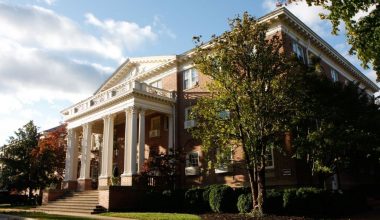If you want to pursue a meaningful and successful career in medicine, New York is one of the best cities to live in. It’s no wonder, then, that New York has more medical schools than any other state, even surpassing California.
New York is home to many of the country’s most famous medical schools, which offer both complete education and connections to top affiliate hospitals. In addition, many of the country’s finest doctors, surgeons, and medical academics not only practice in New York but also teach at prestigious universities.
Table of contents
- Are Medical Schools In New York Difficult To Get Into?
- 17 Easiest Medical Schools To Get Into In New York In 2023
- #1. Touro College of Osteopathic Medicine
- #2. University at Buffalo Jacobs School of Medicine and Biomedical Sciences
- #3. Zucker School of Medicine at Hofstra/Northwell
- #4. School of Medicine and Dentistry at the University of Rochester
- #5. SUNY Upstate Medical University Upstate
- #6. Grossman School of Medicine at New York University
- #7. New York Medical College
- #8. Renaissance School of Medicine at Stony Brook University
- #9 NYU Long Island School of Medicine
- #10. College of Medicine at SUNY Downstate
- #11. Weill Cornell Medical College
- #12. New York Institute of Technology College of Osteopathic Medicine
- #13. Mount Sinai’s Icahn School of Medicine
- #14. Albert Einstein College of Medicine: The College of Physicians and Surgeons of the City University of New York (CUNY)
- #15. Albany Medical College
- #16. Albert Einstein College of Medicine
- #17. Vagelos College of Physicians and Surgeons at Columbia University
- Conclusion
- References
- Recommendations
Are Medical Schools In New York Difficult To Get Into?
Because of the city’s reputation in research and scholarship, getting into medical schools in New York is difficult. Each year, thousands of people apply to medical schools in New York. According to U.S. News and World Report, New York had three of the top ten medical schools in the country in 2020. Several state institutions provide in-state residencies at a lower tuition rate, making these great medical schools more accessible. There are also a few good osteopathic medical schools in the area.
17 Easiest Medical Schools To Get Into In New York In 2023
#1. Touro College of Osteopathic Medicine
Touro College of Osteopathic Medicine has two locations in New York: one in Harlem and one in the Hudson Valley. Touro’s mission is to deliver healthcare to underserved communities by training physicians to assist them and increasing the number of physicians from underrepresented minority backgrounds.
Touro’s preclinical curriculum employs a flipped classroom approach and encourages community interaction. Depending on which school they attend, Touro students cycle between clinical settings throughout New York, New Jersey, Pennsylvania, and Connecticut; approximately 80% of Touro’s hospital affiliates are located in underserved rural or metropolitan areas. However, in recent years, some have criticized Touro for a lack of high-quality rotating sites and lower-than-average COMLEX II pass rates.
#2. University at Buffalo Jacobs School of Medicine and Biomedical Sciences
The University of Buffalo, along with Stony Brook University, is one of only two public medical schools in New York to receive a U.S. News research ranking. Due to the relative affordability of in-state tuition and Buffalo’s low cost of living, students can be assured of opportunities to participate in exceptional research and a wide range of clinical training alternatives at a moderate cost, especially if they are New York residents.
Buffalo’s notable characteristics include new, cutting-edge medical school facilities, clinical exposure and mentorship from a community-based physician beginning in the first year, a Global Medicine Program with opportunities to travel abroad, and a medical leadership track.
#3. Zucker School of Medicine at Hofstra/Northwell
Because of the relationship between Hofstra University and the Northwell healthcare system, the Zucker School of Medicine has established a reputation as a rising medical school despite its short history. Small group instruction, case studies, and self-directed, independent studies are all part of Hofstra University’s problem-based learning curriculum.
Hofstra students get hands-on clinical experience early on, and Northwell’s broad network of institutions on Long Island and in New York City assures access to a diverse patient population. Hofstra now has new, cutting-edge educational facilities and research opportunities through Northwell’s Feinstein Institutes.
Read Also: 9 Cheapest Medical Schools in Chicago In 2023
#4. School of Medicine and Dentistry at the University of Rochester
Rochester is known for its revolutionary biopsychosocial educational paradigm, which treats patients by incorporating biological, psychological, and social factors into treatment. Rochester University calls itself the “Liberal Arts School of Medicine,” emphasizing an interdisciplinary, humanities-focused medical curriculum with concentrations in medical humanities and bioethics, medical education, and global health.
Small class sizes, accurate pass/fail to mark, and excellent research possibilities are also highlights of the university. Students at the University of Rochester Medical Center, one of Upstate New York’s leading medical care and research institutions, begin their clinical training in their first year and engage with a wide range of patients, including those from underserved neighborhoods.
#5. SUNY Upstate Medical University Upstate
SUNY Upstate, situated in Syracuse, has a geographically defined goal of improving the health of the communities it serves. This is in accordance with the Rural Medicine Scholars Program, which attempts to address the physician shortage in rural areas of Central New York.
SUNY Upstate students have access to University Hospital, the region’s sole academic medical center, and Level 1 trauma center. SUNY Upstate also has a campus in Binghamton, where students can obtain more hands-on experience with patients and attending physicians in a smaller, community-based setting—roughly a quarter of each class transfers to the Binghamton campus in their third year. (Xanax) SUNY Upstate offers a pass/fail to mark, optional lectures, a low cost of living, and in-state tuition for New York residents.
#6. Grossman School of Medicine at New York University
NYU stood out from the crowd when it declared in 2018 that all accepted students will get free tuition. Despite the fact that it was already a tough medical school, applications climbed by over 50%. NYU is a top-five medical school with a strong clinical and scientific reputation.
NYU’s innovative, flexible curriculum includes early exposure to clinical medicine, multidisciplinary teaching, and individualized research through intellectual concentrations and tough electives known as “selective.”
Clinical education is provided to students at NYU Langone Health and their primary affiliate hospitals, Bellevue Hospital and the Manhattan VA Hospital. Besides its traditional four-year MD program, NYU offers a three-year accelerated MD program that allows students to gain early, conditional admission to NYU residencies.
#7. New York Medical College
The largest entering class size among allopathic medical schools in New York is at New York Medical College, which is located in suburban Westchester County. As indicated by students’ early exposure to community-based primary care and the school’s lengthy history of admitting women and racial minorities dating back to the 1860s, NYMC emphasizes a humanistic, inclusive approach.
At NYMC, students can take a pass/fail course and participate in exchange programs with medical schools in Japan, Korea, Hungary, and Israel. NYMC shares a campus with Westchester Medical Center and Maria Fareri Children’s Hospital; these facilities, together with Metropolitan Hospital Center in Harlem, serve as NYMC’s primary rotation sites, providing students with a broad range of clinical experiences.
#8. Renaissance School of Medicine at Stony Brook University
Stony Brook University is New York’s top-ranked public medical school, featuring significant research, a rich global health program with options to study abroad, a professional identity-building curriculum, and comparatively low in-state tuition (note: out-of-state students are generally eligible for in-state tuition beginning in the second year). Stony Brook University Hospital, Long Island’s only tertiary care center, and Level 1 trauma center, serves as a training ground for students.
Stony Brook also offers a Scholarly Concentrations Program, which allows medical students to focus their studies in one of four areas, as well as an accelerated three-year MD program with conditional acceptance. Stony Brook also offers a Scholarly Concentrations Program, which permits medical students to pursue study in one of four fields, as well as an accelerated three-year MD program with conditional entrance to a residency at Stony Brook.
SEE ALSO: Accredited Physician Assistant PA Schools in Alabama 2023
#9 NYU Long Island School of Medicine
NYU’s Long Island-based program, known as NYU-LISOM, is a brand new three-year MD program with the goal of increasing the number of primary care physicians. NYU-LISOM, like NYU Grossman, offers tuition-free programs, making it simpler for students to pursue lower-paying primary care specializations.
NYU-LISOM is a tiny program that presently accepts only 24 students per year, with plans to gradually grow that number to 40 in the future. NYU-program LISOM emphasizes integrated care, population health, and health systems science in training students to be primary care leaders. Conditional early admittance to a residency at NYU Langone Hospital-Long Island is one of the benefits of attending NYU-LISOM.
#10. College of Medicine at SUNY Downstate
SUNY Downstate Medical Facility, being the sole academic medical center in culturally diverse Brooklyn, provides outstanding clinical training to students through its own University Hospital of Brooklyn and its many clinical affiliates.
As a result, it focuses on treating the underserved and tackling urban-specific medical challenges. A range of integrated pathways (e.g. global health, social determinants of health, and medical education) are available to students at SUNY Downstate, as well as pass/fail to grade non-mandatory lectures and early clinical exposure. As a public medical school, SUNY Downstate also offers in-state tuition to New York citizens.
#11. Weill Cornell Medical College
Weill Cornell is a top-tier university with an Ivy League prestige and financial aid that is debt-free. Cornell is distinguished by its progressive curriculum, which emphasizes active learning, self-directed research, and small groups over traditional lectures. Cornell is also known for its global health focus, with students able to provide clinical care and undertake research in 62 countries.
Because Cornell shares a campus with multiple other prestigious medical institutions, like New York-Presbyterian Hospital and Memorial Sloan Kettering Cancer Center, students benefit from top-tier research opportunities and excellent clinical exposure to a diverse patient population.
#12. New York Institute of Technology College of Osteopathic Medicine
NYITCOM is a Long Island-based osteopathic medical school dedicated to patient-centered, population-based healthcare. It focuses on preparing students to practice in inner cities, rural settings, and international areas. NYITCOM also has a newer campus in Jonesboro, Arkansas, and applicants can specify if they want to be evaluated for both. NYITCOM has a technology-infused curriculum that includes telemedicine, robotics, and synchronized lectures across campuses.
Students also benefit from a pass/fail curriculum as well as non-mandatory, streamable courses.NYITCOM has been chastised in recent years for a number of reasons, including its huge entering class size (usually around 320 students each year), high attrition rate (more than 10%), and loss of several hospital affiliations as additional medical schools emerged in and around New York City. Nonetheless, each year, NYITCOM offers rotations at a variety of locations throughout the New York City metro area, allowing students to select from a wide spectrum of clinical experiences.
#13. Mount Sinai’s Icahn School of Medicine
The mission of the Icahn School of Medicine is to train ambitious, creative physicians and scientists who will transform medicine through innovation and activism. Its educational philosophy, which it describes as “combining the best traditions of medicine with the values and entrepreneurial thinking of a startup,” reflects this emphasis on change.
Icahn is known for its pass/fail, flexible curriculum (as evidenced by the name of its early assurance program, FlexMed)—for example, students can choose to do a year-long scholarly project, and all four years include “Flex Time” for self-directed, individualized learning, discovery, and leadership development. Icahn is one of the few medical schools in the United States that is also a hospital, giving its students access to top-notch clinical training and research possibilities.
READ ALSO: 10 Medical Scholarships in USA for Students from Developing Countries| 2023
#14. Albert Einstein College of Medicine: The College of Physicians and Surgeons of the City University of New York (CUNY)
The CUNY School of Medicine is a relatively new medical school with a stated mission: to increase access to medical education for students from underprivileged, underrepresented areas with low financial resources, as well as to train primary care physicians to serve these communities. It’s worth noting that CUNY only offers a seven-year BS/MD program that students can begin as freshmen; the university does not currently offer a separate MD program.
The med school curriculum places a strong emphasis on population health and how it affects wellness and disease prevention because of CUNY’s primary care concentration. Students get their first taste of clinical work during their three-year undergraduate study, and then continue their clinical training through rotations in the Bronx, Staten Island, Harlem, and Queens.
READ ALSO: 10 Best Medical Schools in Florida 2023
#15. Albany Medical College
Albany Medical College is an Albany, New York-based medical school. As one of the country’s oldest private medical colleges, Albany Medical College has a long and storied history and reputation. Albany Medical Center Hospital, the state’s busiest Level 1 trauma center and the only academic medical center in northern New York, sits on the same site as Albany; Albany students cycle here and at other nearby facilities to get a comprehensive range of clinical experiences.
Albany offers a fairly normal medical school curriculum and is known for its small class sizes and modified pass/fail to mark system, as one of only a few medical schools outside of the New York City metro area.
#16. Albert Einstein College of Medicine
Albert Einstein College of Medicine in New York City is a well-known medical school. Students at Albert Einstein College of Medicine in the Bronx get a diverse spectrum of clinical experience through serving a diverse, underserved patient population.
This is backed up by Einstein’s emphasis on community engagement to boost health, as well as a long-term curricular theme focusing on population health. Students at Einstein have access to a true pass/fail curriculum as well as optional video courses. Furthermore, Einstein is noted for their excellent research; in order to graduate, all students must write a scholarly paper based on mentor-guided research.
#17. Vagelos College of Physicians and Surgeons at Columbia University
Columbia became the first medical school in the country to replace all loans with scholarships for students who qualified for financial aid in 2018, making it a highly desirable med school for many. This, combined with its top-ten ranking and Ivy League prestige, has made Columbia a highly desirable med school for many.
Non-medical curricular threads, such as public health and biomedical informatics, are prominent in Columbia’s curriculum, as is an emphasis on narrative medicine, a field that Columbia pioneered; a Differentiation & Integration block, in which students take electives and work on a scholarly project; and numerous other opportunities to benefit from Columbia’s research.
On the clinical side, Columbia students rotate between a variety of hospitals in the New York City area as well as the school’s free, student-run clinics. The Columbia-Bassett track, which focuses on rural medicine, is also available.
Conclusion
It’s not simple to get into medical schools in New York. It’s no wonder that New York is one of the most desirable places to pursue a medical degree, given its cultural cachet, vast population, and numerous outstanding schools. Despite being the country’s fourth-most populous state, New York has the most medical schools of any state.





